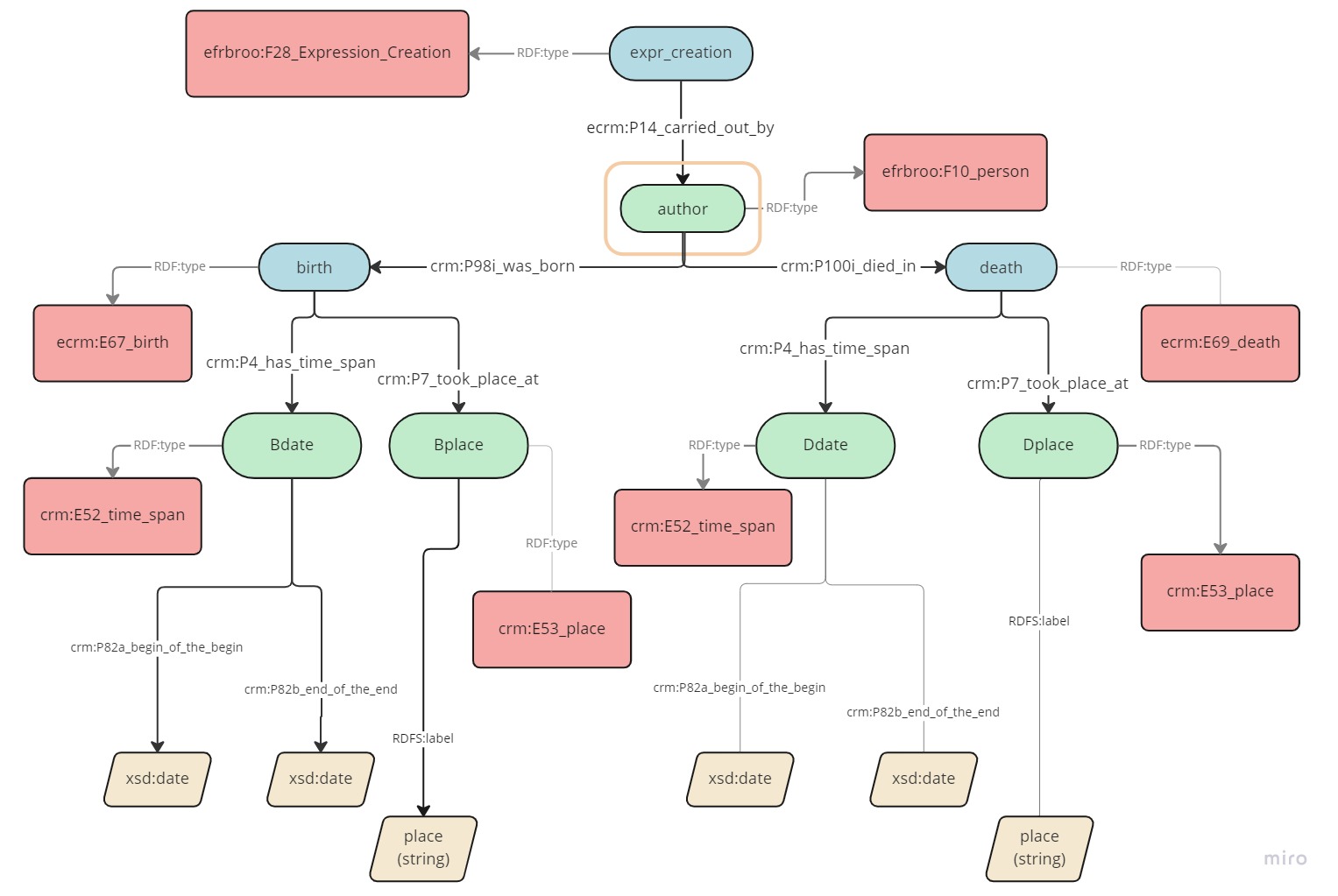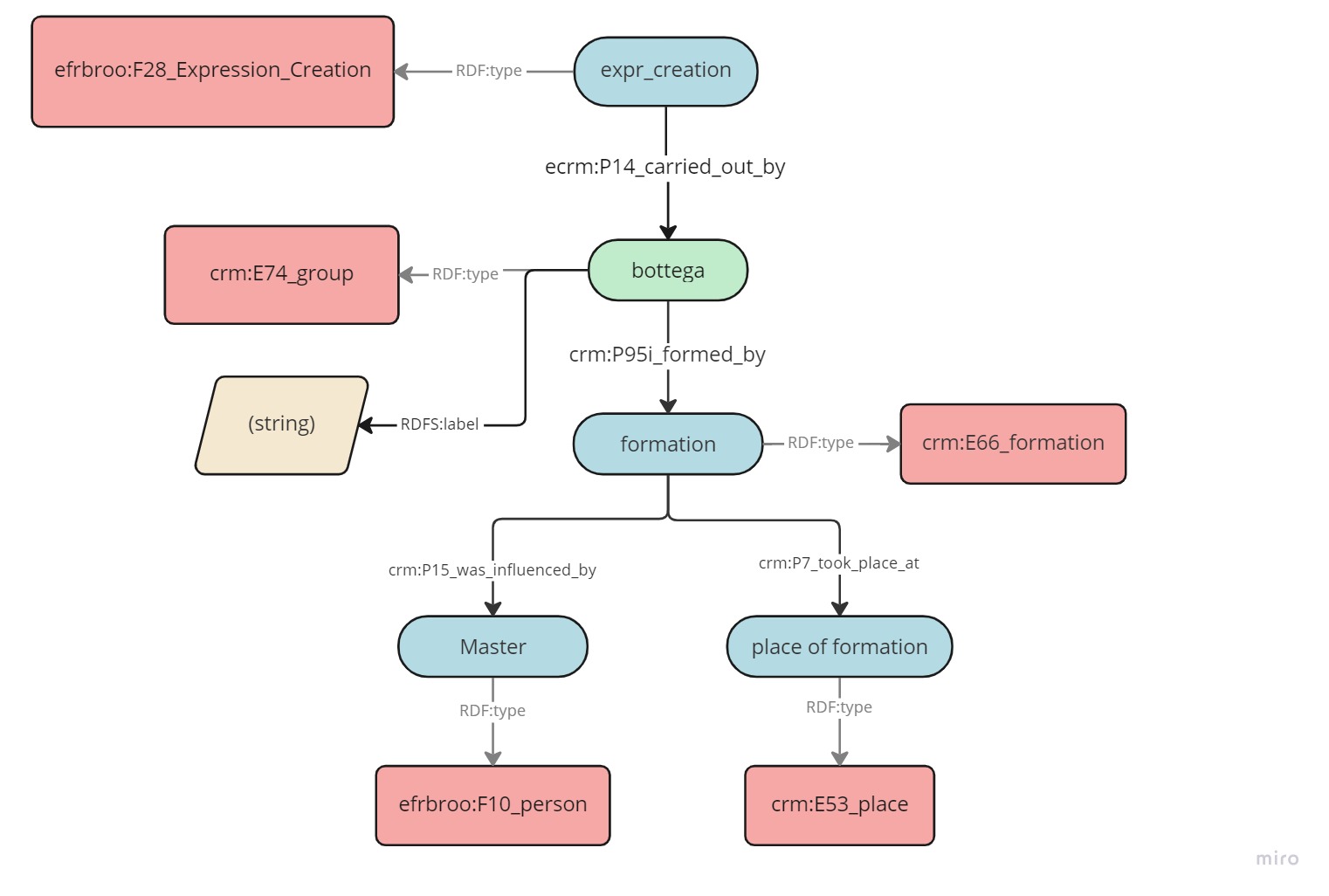Conceptual Model
The model represents the collection of descriptive metadata. The conceptual model is based on CIDOC CRM conceptual model and EFRBRoo andintegrates when needed, some other ontologies.
The core concepts: creation, expression and manifestation
The foundation of the conceptual model is composed of a triad of concepts from FRBRoo which describe each item, namely (1) the item as the product of intellectual creation, (2) as an actual expression and (3) as a unique physical manifestation.
Every item of the collection is represented by (1) an expression creation URI (named after the original item id plus a prefix “expr_creation”), of class efrbroo:F28_Expression_Creation; the expression creation is related to both (2) an expression URI (named after the original item id plus a prefix “expr”), of class efrbroo:F2_Expression, linked through the property efrbroo:R17_created, and (3) a manifestation URI (named again after the original item id plus a prefix “manif”) of class efrbroo:F4_Manifestation_Singleton, linked through the property efrbroo:R18_created.
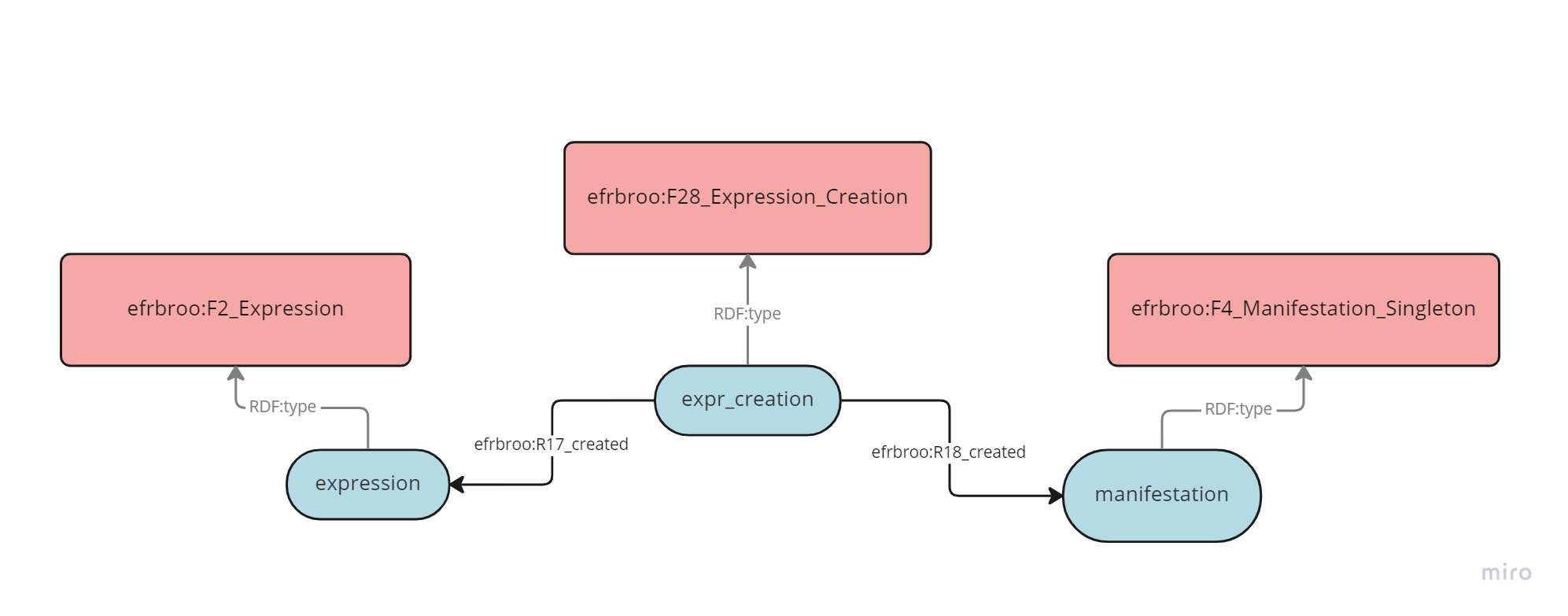
Expression creation and its description: the intellectual work
Dating
The expression creation is an event that occurs (property ecrm:P86_falls_within) in a period of time, represented with the “dating” URI, having class ecrm:E52_Time-Span. The model here follows as before: the two points in time are defined by a first machine-readable date object (crm:P82a_begin_of_the_begin property) and a second similar date object (crm:P82b_end_of_the_end property); and the URI is also labelled (RDFS:label property) with a Literal string object.
In the original database, dating information is not mandatory and is expressed in different ways: as an exact date, as a period delimited by two dates or as a more general century indication. While it is important to convert all the dates in a machine-readable format - thus with one or two precise points in time in the xsd:date format - these different expressions are crucial to explicitly mark different kinds of fuzziness in chronological data (e.g. “1575” is a simple date, “1740-1815” is a period, “prima metà XVII sec.” is a century ). This is the reason why a “dating type” entity has been added; three URIs can be assigned consequently: dhlod:data_semplice for exact dates, dhlod:data_periodo for a delimited period of years, and dhlod:data_secolo for centuries.
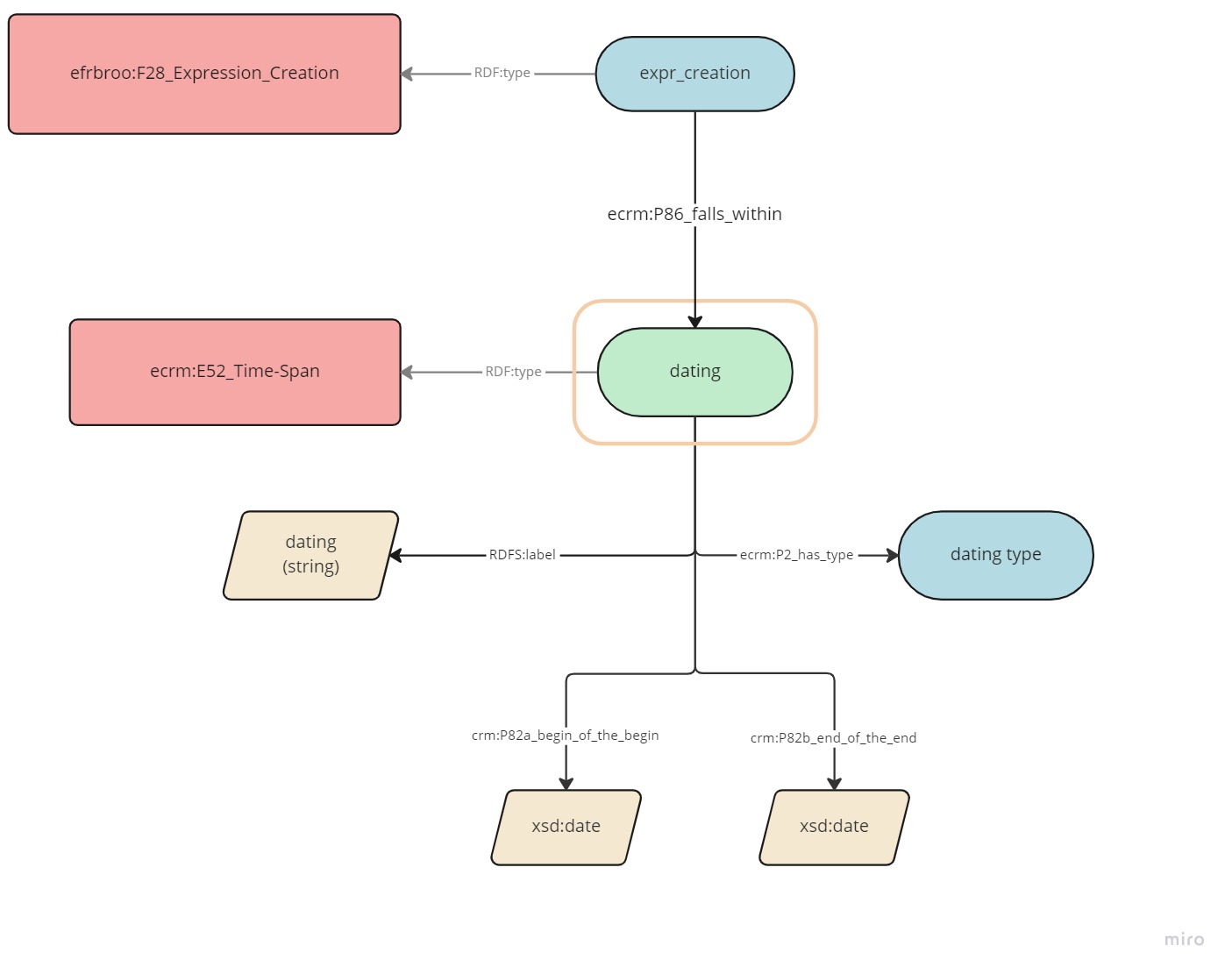
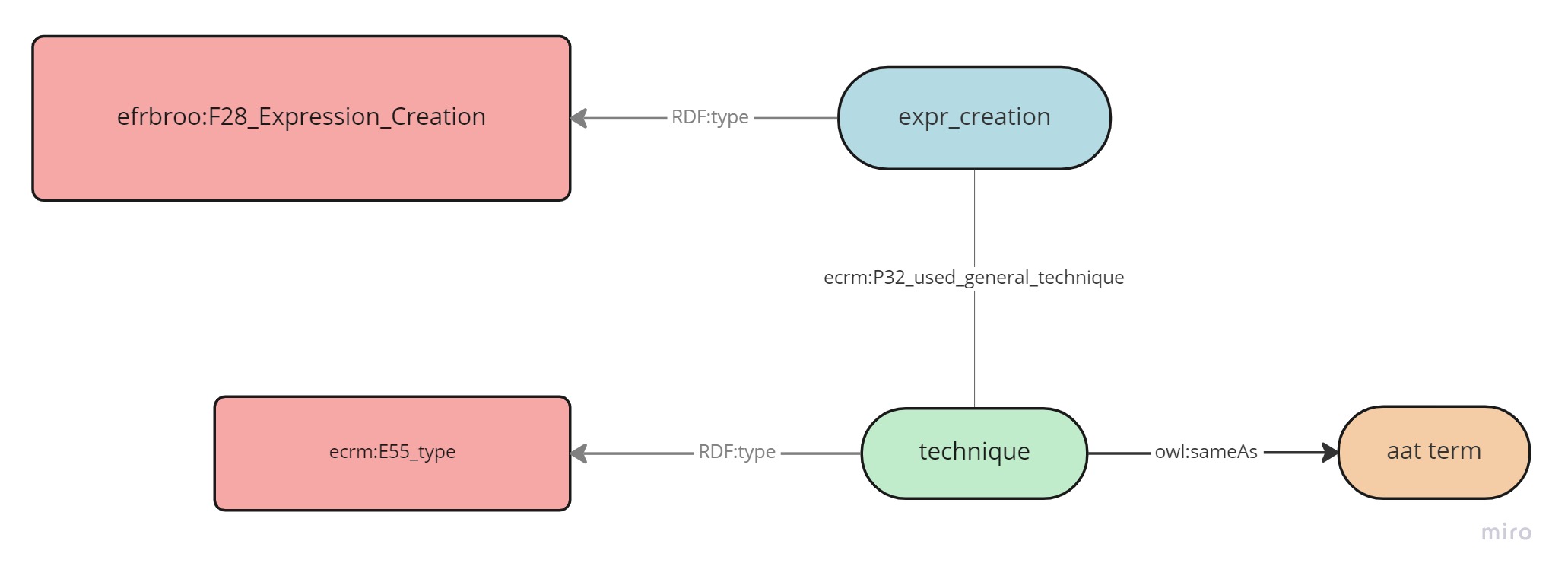
Technique
Despite its importance, information about technique is unavailable for all items in the archival collection, but only for the categories “Dipinti” and “Disegni”. In the model the technique is an entity of class crm:E55_Type and is directly linked to the expression creation entity to the property ecrm:P32_used_general_technique.
The alignment is represented by the property owl:sameAs, which connects the technique URI with the URI of the term from the AAT taxonomy.
Expression and its description
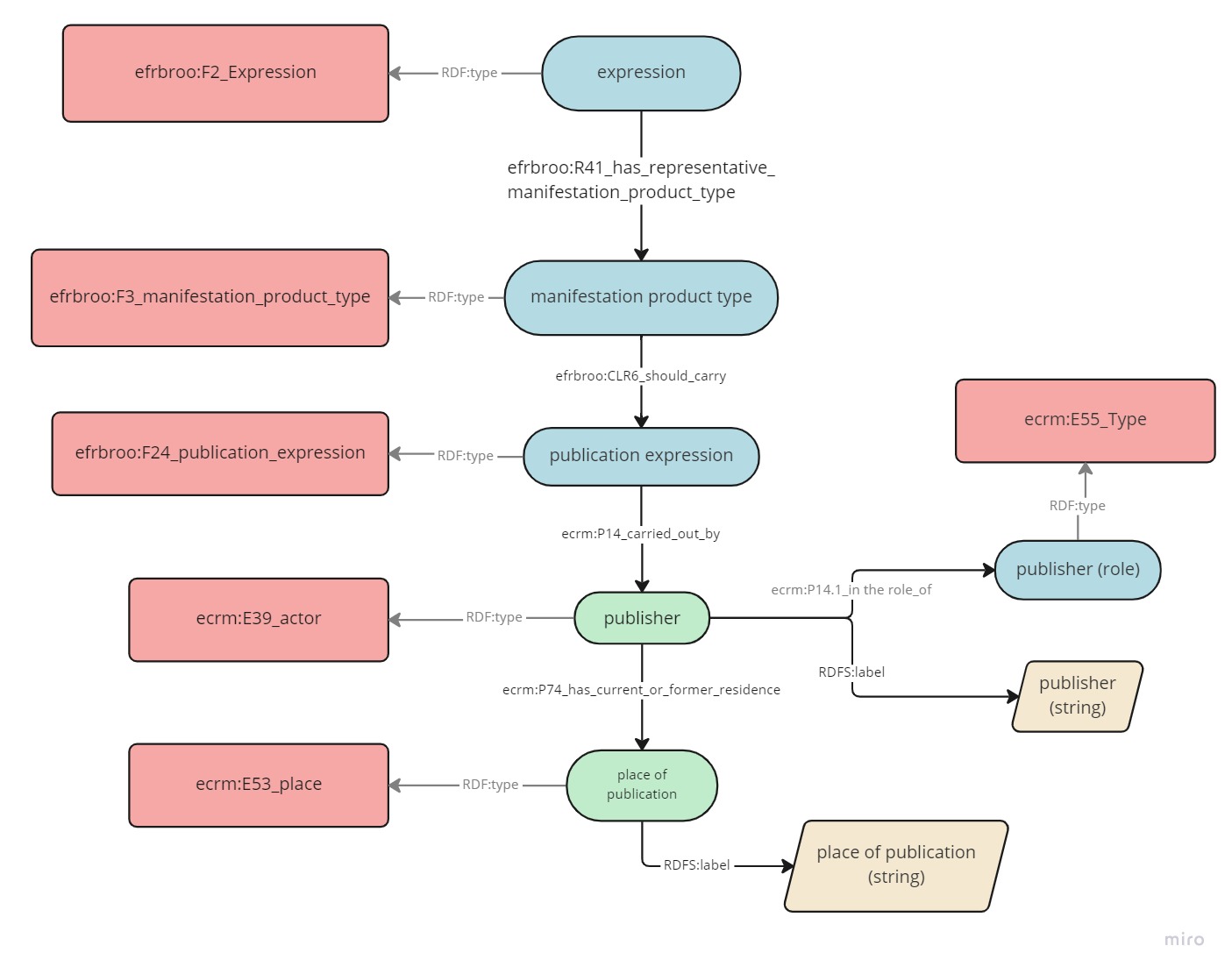
Publisher and place of publication
The publication and the relative metadata are described in the model following the CIDOC-CRM approach. As shown in figure 4.6, the expression is physically embodied (property efrbroo:R41_has_representative_manifestation_product_type) by a manifestation product type (automatically generated URI of class efrbroo:F3_manifestation_product_type)82. The latter is an object that carries (property efrbroo:CLR6_should_carry) the content as graphically edited and organised by the publisher: this concept is expressed by the publication expression URI, an entity of class efrbroo:F24_publication_expression. The publisher is thus the person responsible (ecrm:P14_carried_out_by property) for the publication expression. The publisher URI is generally classified as actor (crm:E39_Actor) and specified by the property ecrm:P14.1_in_the_role_of, which assigns the role of publisher (role URI) among other possible types of roles (entity of class ecrm:E55_Type). It is also made available the string expressing the publisher, through the RDFS:label property.
Moreover, when available, the data about the place of publication are expressed as the place in which the publisher resides (publisher URI, ecrm:P74_has_current_or_former_residence, place of publication URI; and place of publication, is a object of class ecrm:E53_Place, having a string as a label (RDFS:label property).
Category
The archival items have been classified by the Collections Taxonomy. In the conceptual model, a type assignment (property ecrm:P2_has_type) draws a direct relationship between the intellectual work (expression URI) and the category term from the Collections Taxonomy.

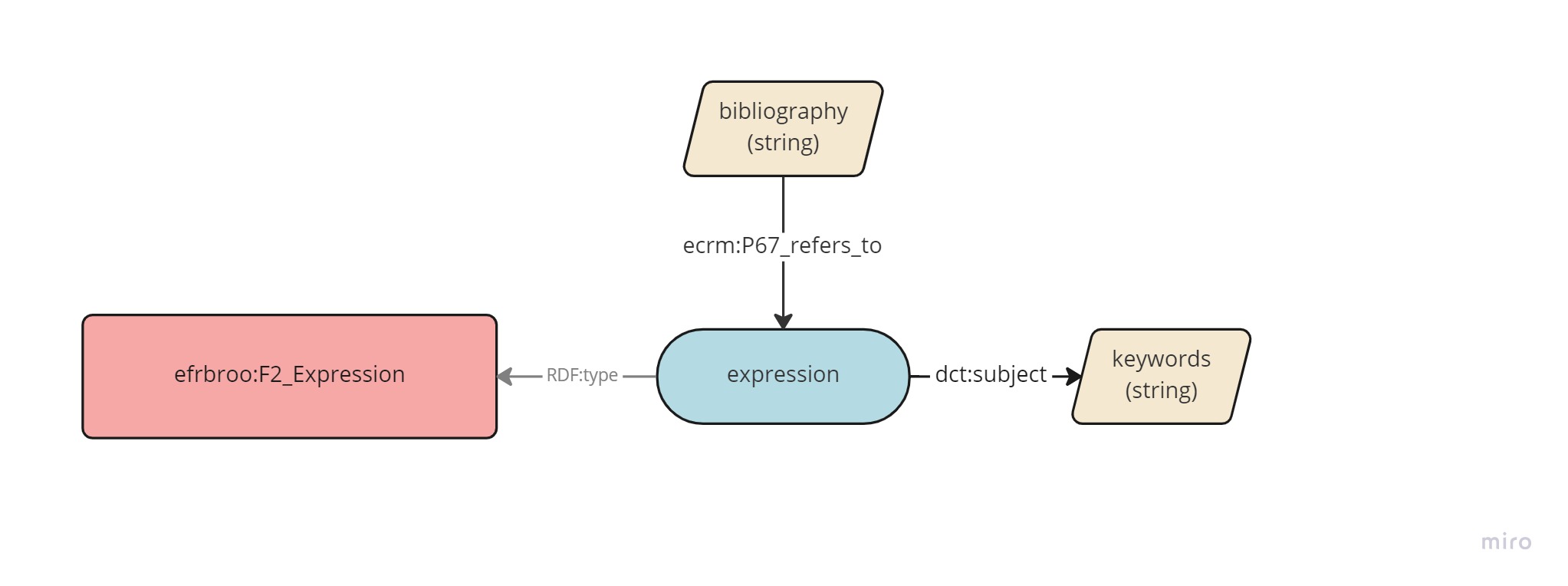
Bibliography and Keywords
The item expression is about (property dct:subject) some main themes, that are he expressed as a Literal object (the keywords string). Additionally, some bibliographic references (string) describe (ecrm:P67_refers_to) the content of an item (efrbroo:F2_Expression).
Manifestation and its description: the physical item
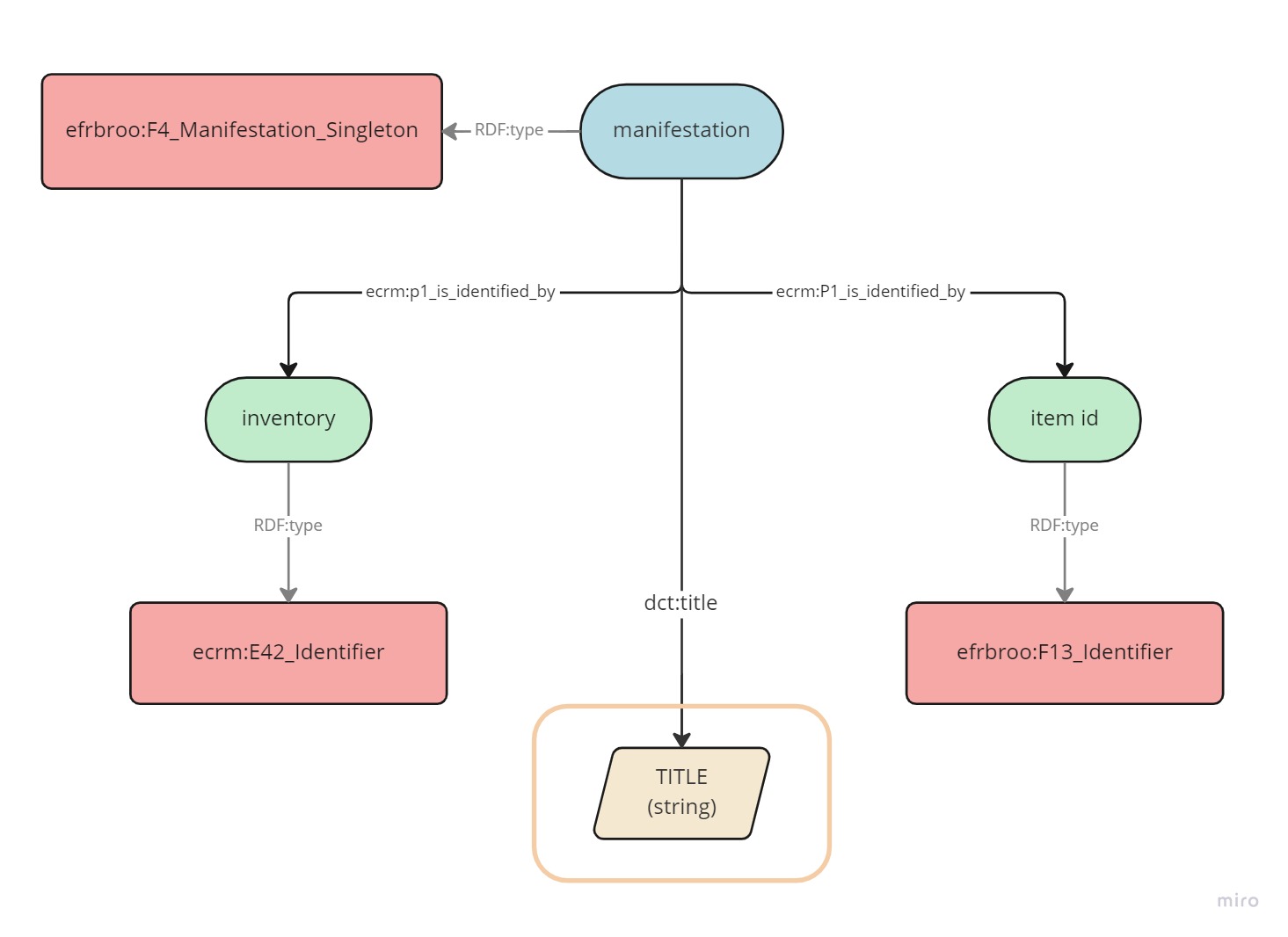
Identification: title, item id and inventory number
The model comprehends three ways for item identification:
- the title, which is here represented as a Literal string object and is linked to the manifestation URI via the property dct:title.
- the inventory number (unique code assigned to the item in order to catalogue it and retrieve it in the physical archive, represented as instance of class ecrm:E42_Identifier)
- the item identifier (alphanumeric code, unique for each item, but automatically generated by the database management software and referring to database item, represented as an instance of the class efrbroo:F13_Identifier) are both related to the manifestation URI through the property ecrm:p1_is_identified_by as shown in figure 4.9.
Physical description: dimension, pagination, ligature, support, iconography
The physical description describes a plethora of archival objects of different types that carry a variety of physical features.
The dimension is common to bibliographical and artistic objects and is represented in the data model as in CIDOC CRM: a manifestation URI has dimension (ecrm:P43_has_dimension), a URI belonging to crm:E54_Dimension. Each dimension is connected with the measurement unit URI (ecrm:E58_Measurement_Unit), and the actual dimension value (ecrm:E60_Number).
The further descriptions of the manifestation regard its vessel and the manufacturing of the object itself: the manifestation URI is related via the property ecrm:P45_consist_of to the physical man made thing URI (class ecrm:E24_Physical_Man-Made_Thing), that “comprises all the persistent physical items that are purposely created by human activity” (ICOM/CIDOC Documentation Standards Group, 2020). Artwork iconography is specifically represented with the triple “manifestation URI ecrm:P62_depicts iconography (string)”.
For the manuscript description, some particular metadata are required: pagination, ligature and support.
The pagination URI (of class ecrm:E18_Physical_Thing) reports how many pages or folios the physical man-made thing is composed of (ecrm:P46_is_composed_of property) and it is also annotated by a Literal string object.
The ligature URI accounts for the material and the technique used for the book ligature (ecrm:P19_bears_feature property): it is an entity of class ecrm:E29_Physical_Feature with its rdfs:label.
Finally, the support URI of class ecrm:E57_Material describes the material of the writing support with the property ecrm:P45_consist_of.

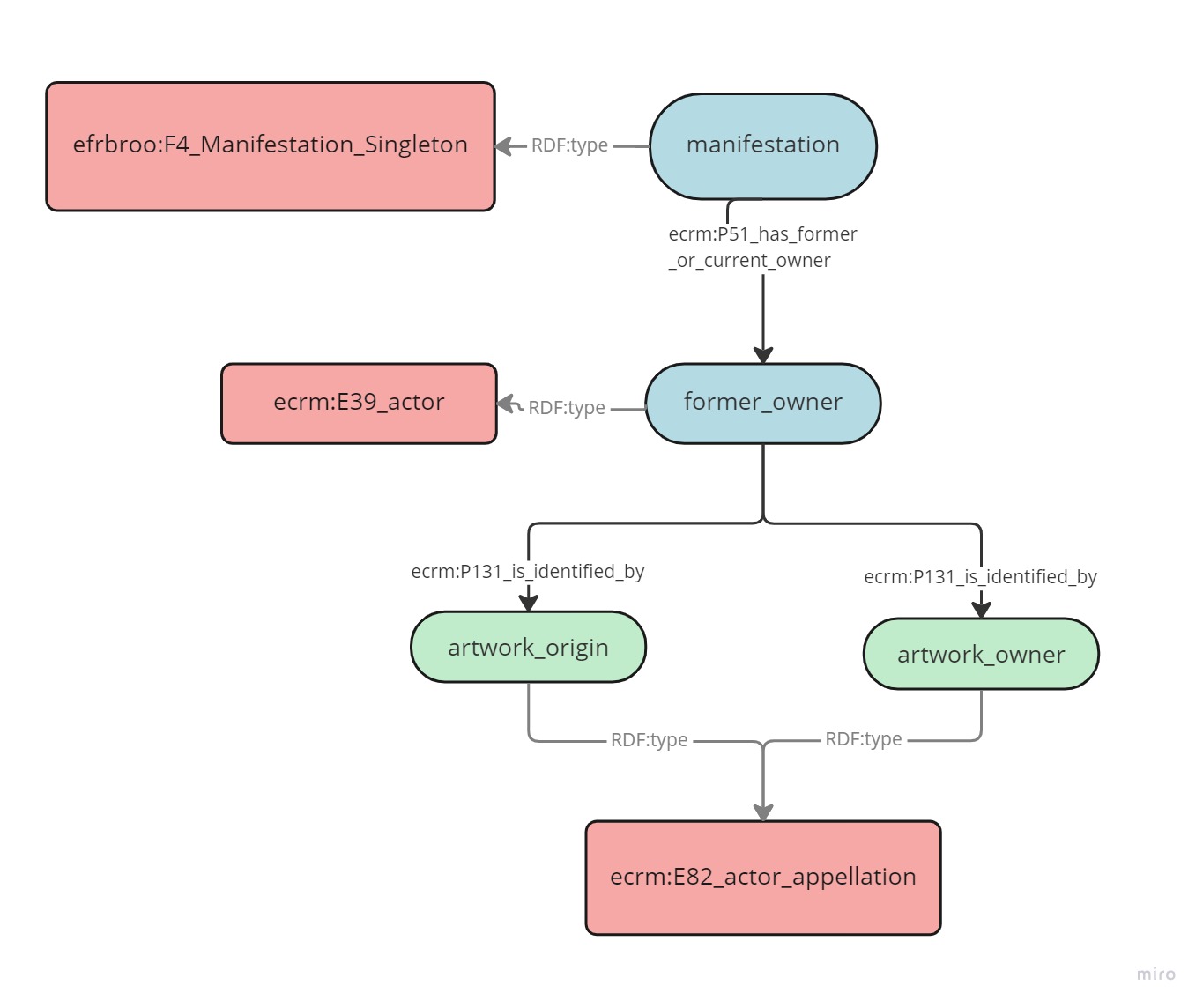
Ownership: artwork owner or artwork origin
The concept of ownership is reported in the model with two fields: “artwork origin” and “artwork owner”. So, in the model the concept of the former owner is expressed by the relation ecrm:P51_has_former_or_current_owner between the manifestation URI and a former owner URI belonging to class ecrm:E39_Actor. The former owner URI can be identified (ecrm:P131_is_identified_by property) by both the artwork origin and the artwork owner data values, expressed as URIs of class ecrm:E82_Actor_Appellation.
Other information: notes, linked resources and related artwork
References of other institutions’ digital catalogues describing the same artwork are represented with the property rdfs:seeAlso. Relations between objects inside the collection are generically represented through the property skos:related. Finally, the commentary notes by the cataloguer are represented as Literals via the property ecrm:P3_has_note.
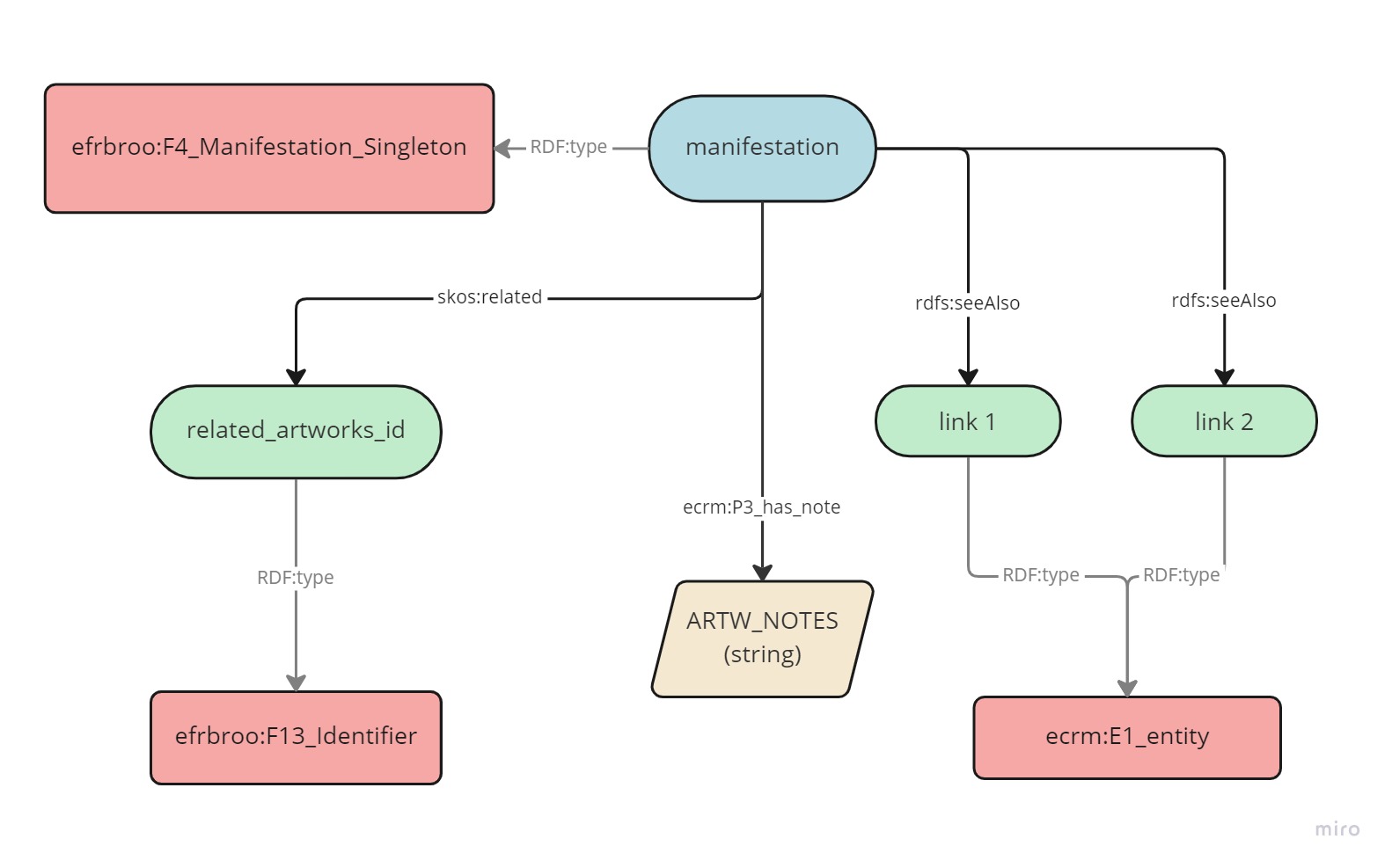
Data deemed to be uncertain
Uncertain Dates
Uncertain dates are modelled following the same structure used for the hypothetical author assignment, described in the previous paragraph.The uncertain information is represented by a unique URI of class crm:E13_Attribute_Assignment, composed with the prefix “DateAttrAss” and the item identifier. The attribution is illustrated through the three same statements: (1) the subject will be again the expression creation URI; (2) the relation will be this time the property ecrm:P86_falls_within; and (3) the object will be a date URI, treated as the other dates in the standard version of the model (having a label and a machine-readable expression of time delimiters).
The textual signals in this case are expressed as date qualifier URIs: the question mark signals an uncertain attribution (date qualifier value unknown); the “circa” substring (date qualifier value circa) enlarges the borders of the time-span; the “post” substring (date qualifier value post) and the “ante” substring (date qualifier value ante) define respectively a post quem term and an ante quem term, and finally all the other substrings are qualified with the value approximation.

Uncertain Titles
The titles deemed to be uncertain are represented in the model using the same structure described before, with some slight differences. As shown in figure 4.17, the URI of the attribution assignment is formed by the prefix “TitAttrAss”. The objects of the three statements about the attribution assignment are respectively the manifestation URI, the dct:title property and the Literal string object containing the attributed title.
Finally, the textual signal is here called Title attribution type and can assume two values: “uncertain_title” if it is a question mark and “attributed_title” for square parenthesis wrapping the string, which is a practice to identify information added by the editor.

